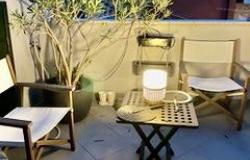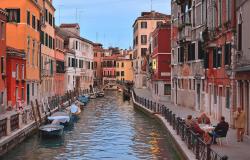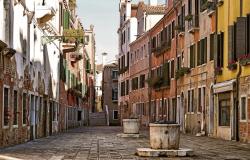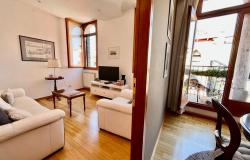Venice's newest art gallery, the Museo Vedova, by celebrity architect Renzo Piano has put a 21st century twist on the art of picture hanging.
Dedicated entirely to the work of the Venetian abstract art pioneer Emilio Vedova (1919-1996), paintings at the Museo Vedova don't hang at all - they float.
Suspended in the air by a fleet of robotic shuttles moving along a track fixed to the ceiling, the paintings glide through the exhibition space at various heights, periodically coming to rest at strategic points under the lights before floating away to a different position.
The paintings are brought out together in series according to their chronological or thematic contexts and then whisked away to a storage space at the back of the museum to be replaced by others.
The public can view the paintings from the floor or from an elevated wooden mezzanine along the wall.
Set to open on June 3 for the 53rd Venice Biennial art exhibition, the Museo Vedova is located in the artist's former studio, a renovated warehouse at the historic Venetian salt docks.
Explaining how he came by the idea for the museum, Renzo Piano explained, ''the warehouses are narrow and long and so it made sense to imagine that down at the far end, a bit hidden in the shadow, would be the storage facility, and out of this, as if by magic, the works would appear in a certain order. From this came the idea of mobility, whereby it's not the spectator who goes to the artwork, but the artwork that comes to the spectator''.
Piano was introduced to Vedova in the 1980s by the composer Luigi Nono, with whom the two collaborated in designing the set for the premiere of Nono's opera ''Prometheus'' at the 41st Venice Biennial in 1984.
A frequent visitor to Vedova's studio, Piano said, ''there was always the feeling that one day that imposing warehouse, a rather magical place or kind of cavern, could be the home for his works. He had always imagined this...and it was obvious that it wasn't a question of hanging works the way one normally does''.
Emilio Vedova was a seminal figure of the post-war avant garde, emerging from the anti-fascist art group ''Corrente'' in Milan to co-found the ''Fronte Nuovo delle arti'' in 1947, a short-lived but prominent movement which looked to the neocubism of Pablo Picasso as the model for a modern new aesthetic.
His career exploded in the 1950s with a solo show in the prestigious Catherine Viviano Gallery in New York followed by his inclusion in the landmark exhibition ''Gruppo degli otto pittori italiani'' at the 26th Venice Biennial in 1952, which established him among the foremost abstract artists in Italy.
Vedova would return to the Biennial eight years later to claim the Grand Prize for painting.
From the dark geometries of his experiments with cubism, Vedova's work from 1950 onward grew increasingly abstract, placing him in league with the European ''Art Informel'' movement that paralleled the work of abstract expressionists in America like Jackson Pollock and Willem de Kooning.
''My [works] are not creations, but earthquakes,'' Vedova once said.
''They are not paintings, but breaths''.
Vedova's experimenting would eventually carry his work off the canvas altogether into the groundbreaking new terrain of artificial light play and installation art, for which he was featured in the Italian pavilion at the 1967 International and Universal Exposition in Montreal.
Vedova died in 1996 at the age of 87.
In addition to the cutting edge new Museo Vedova, his works are also on display at the nearby Peggy Guggenheim collection as well scores of other galleries and museums around the world.










